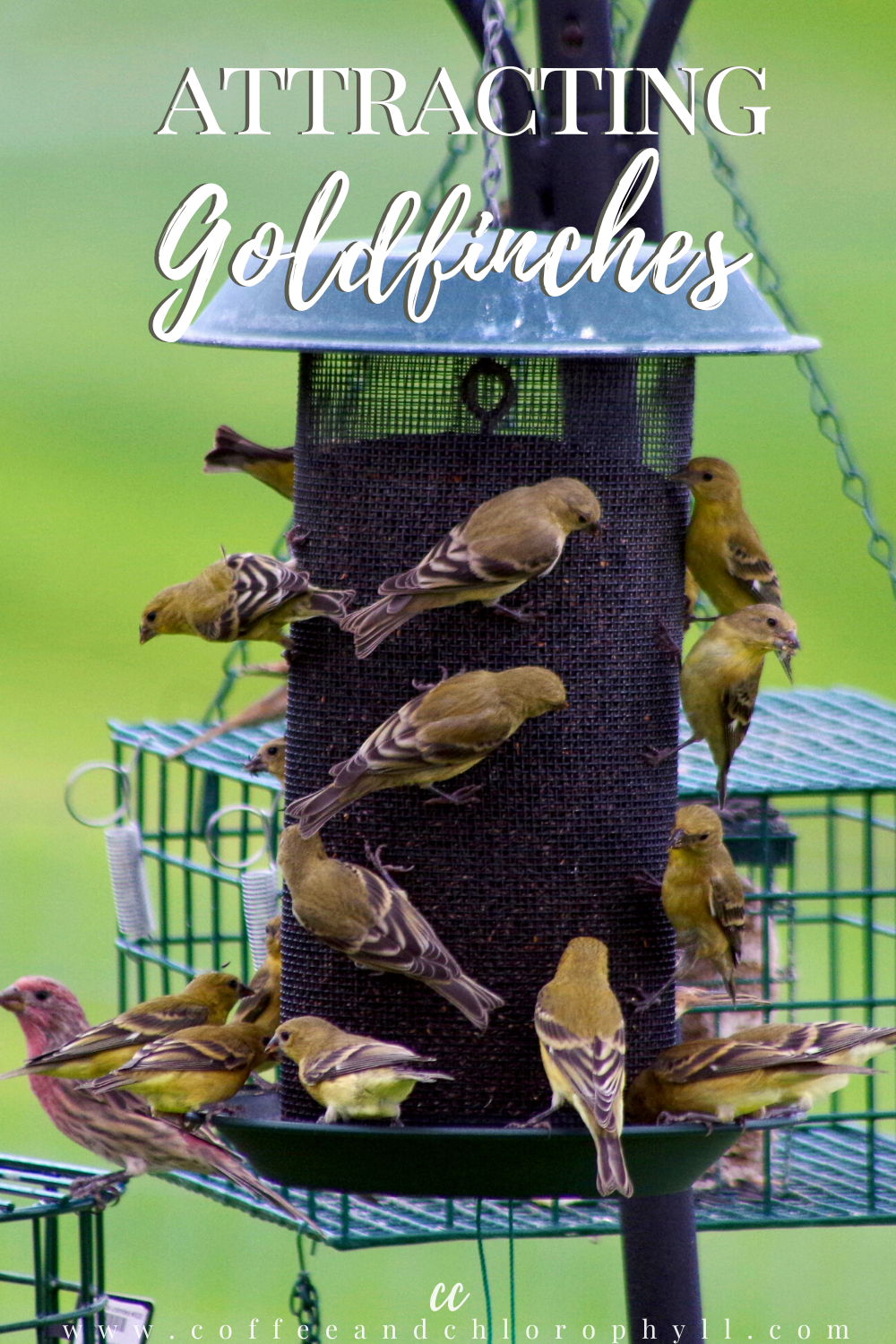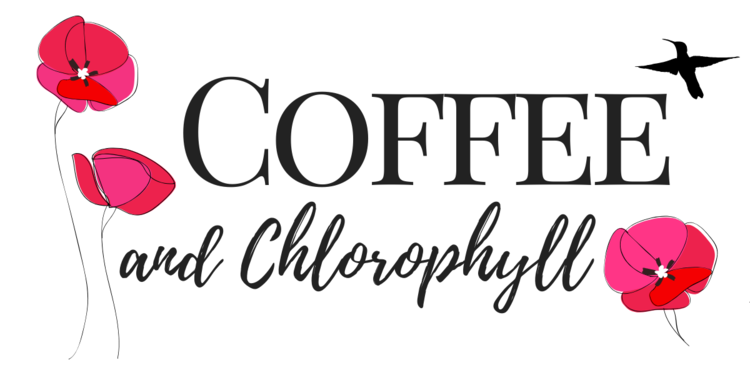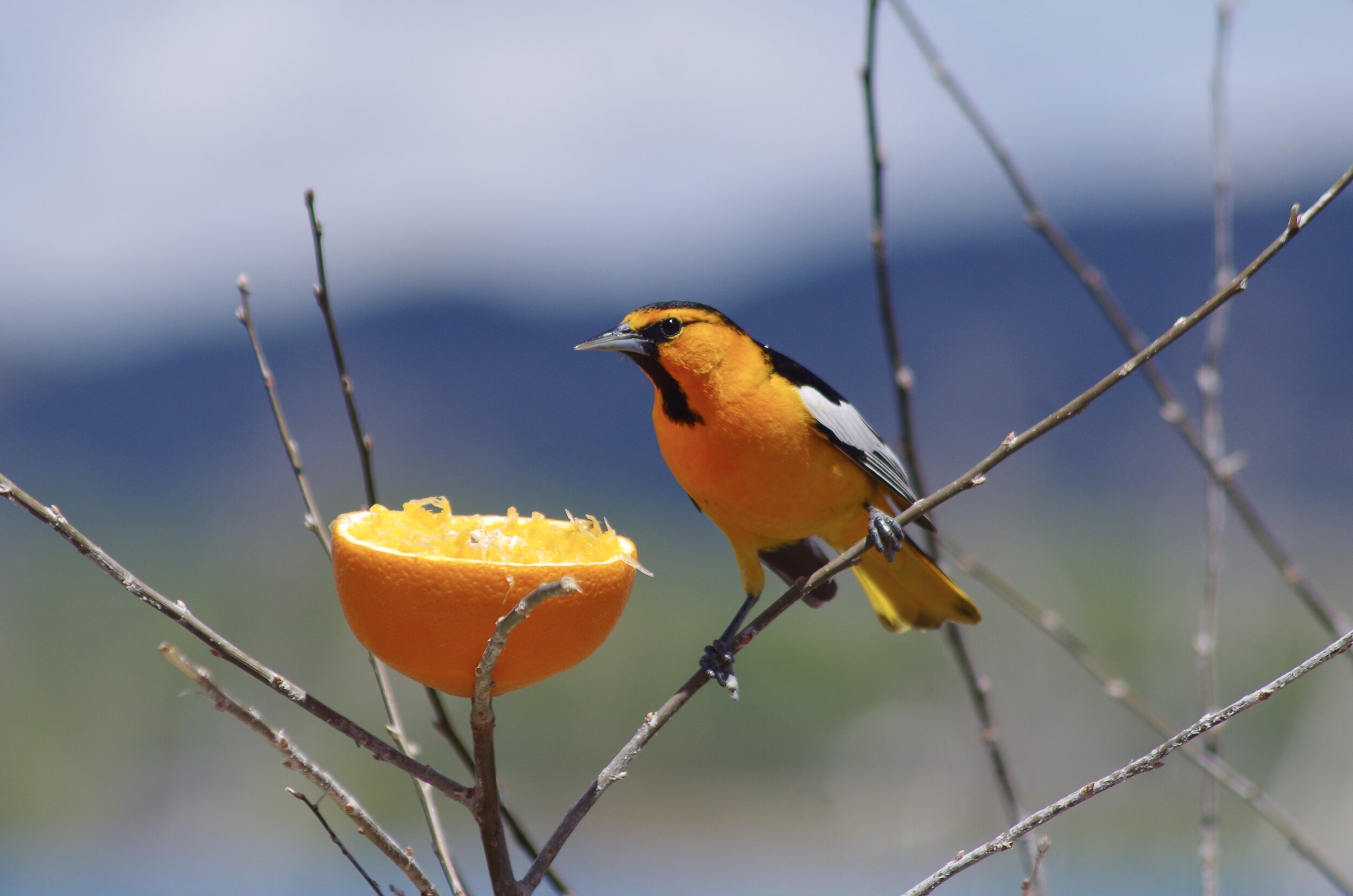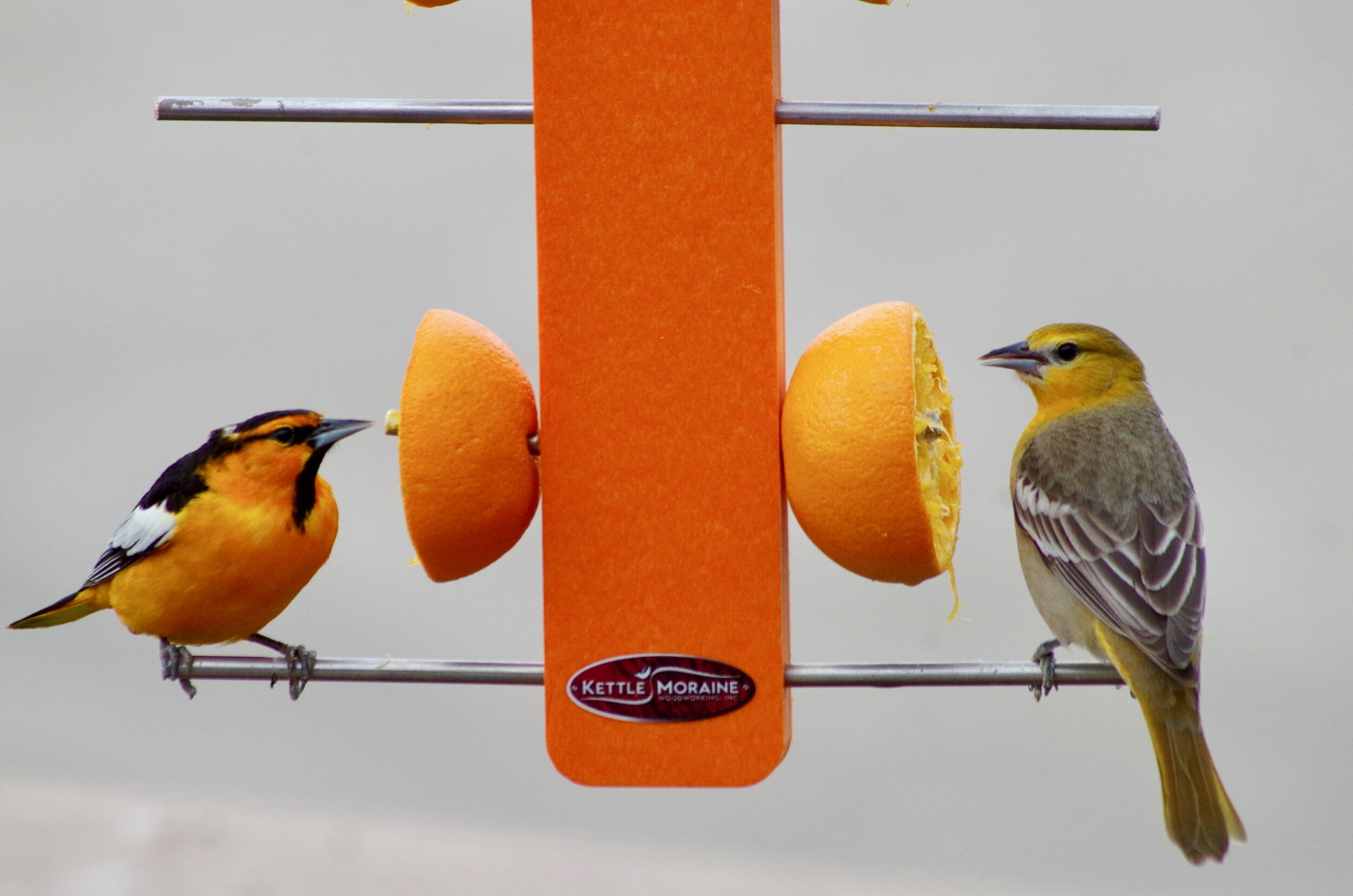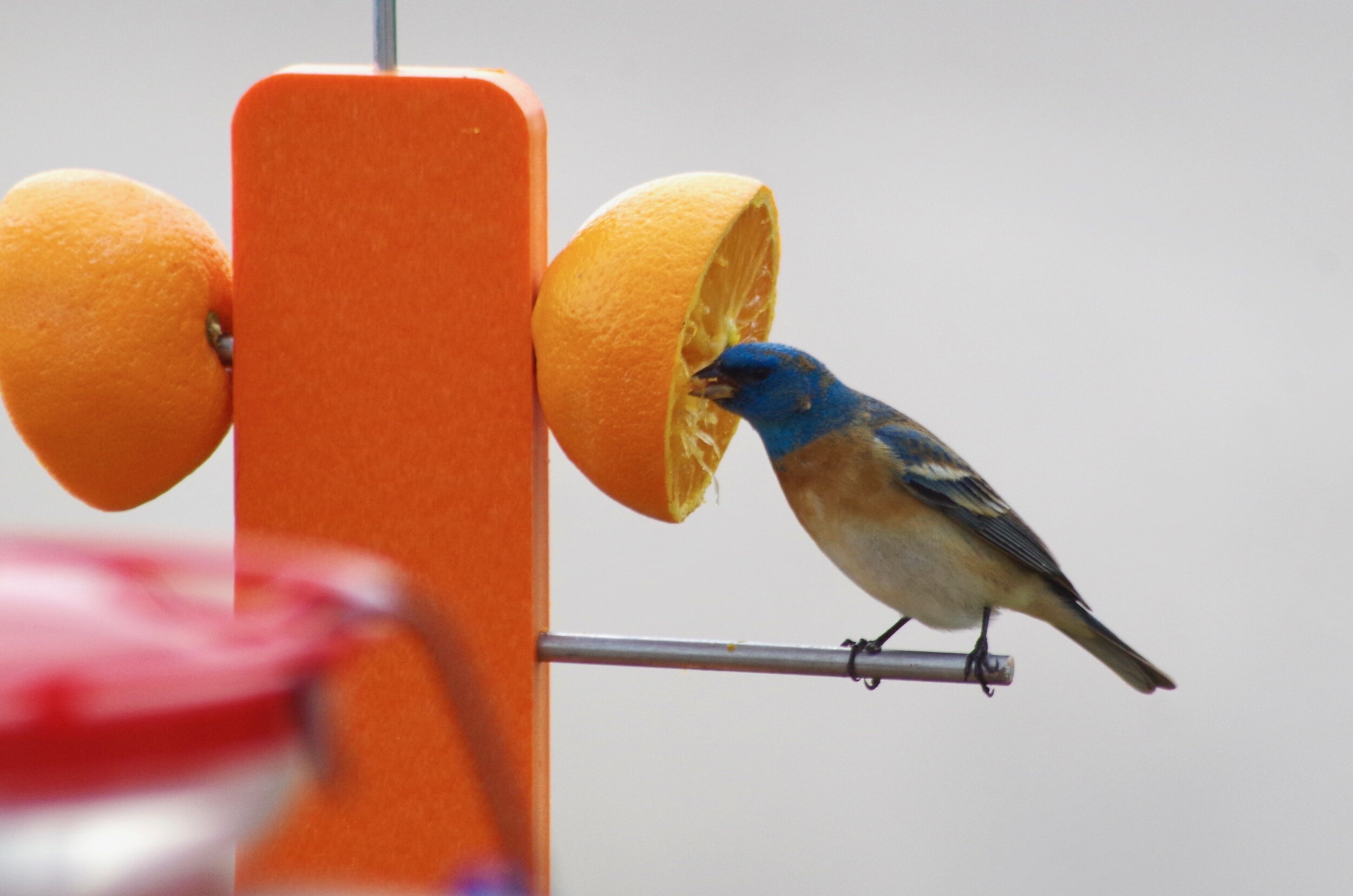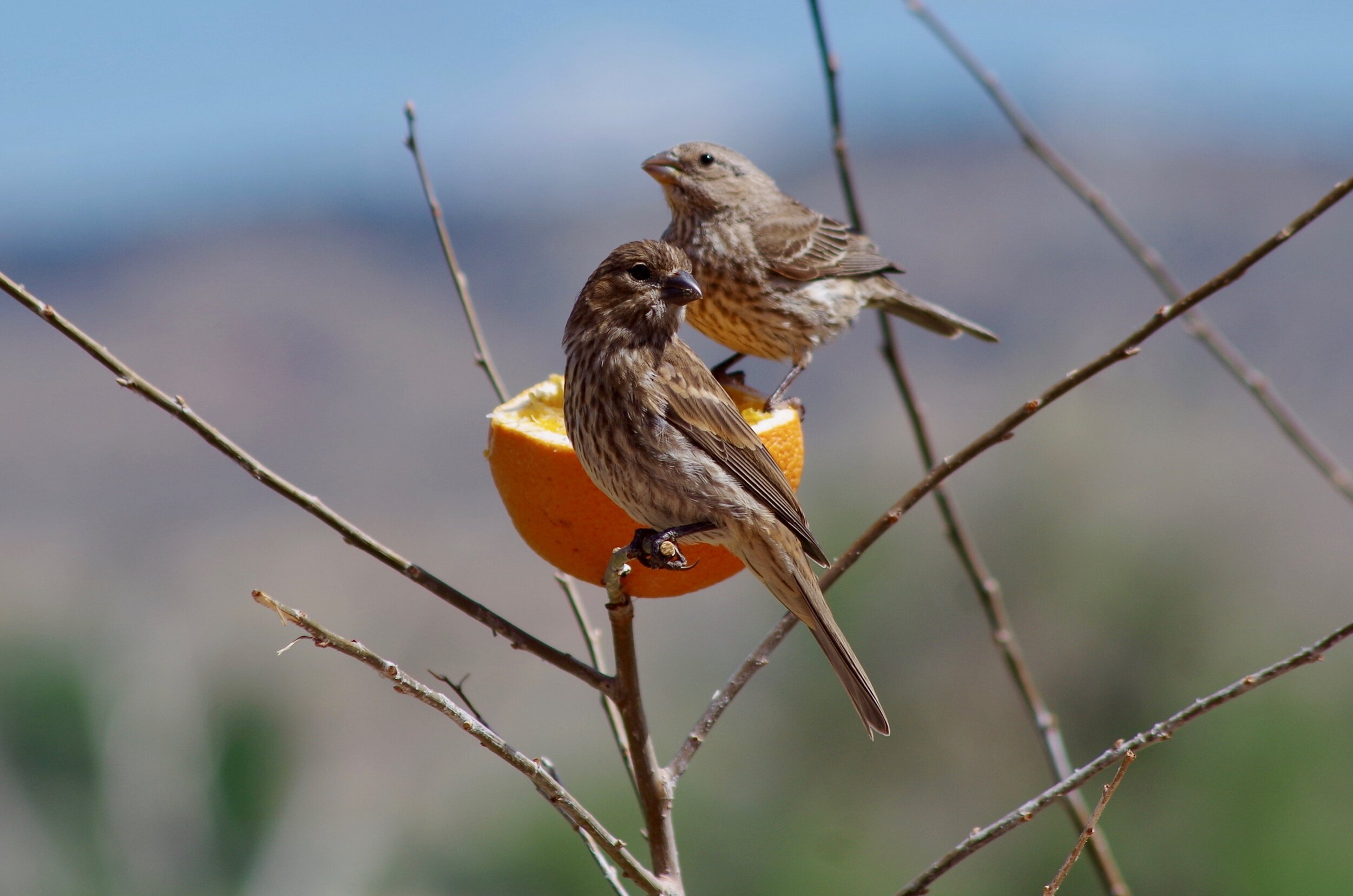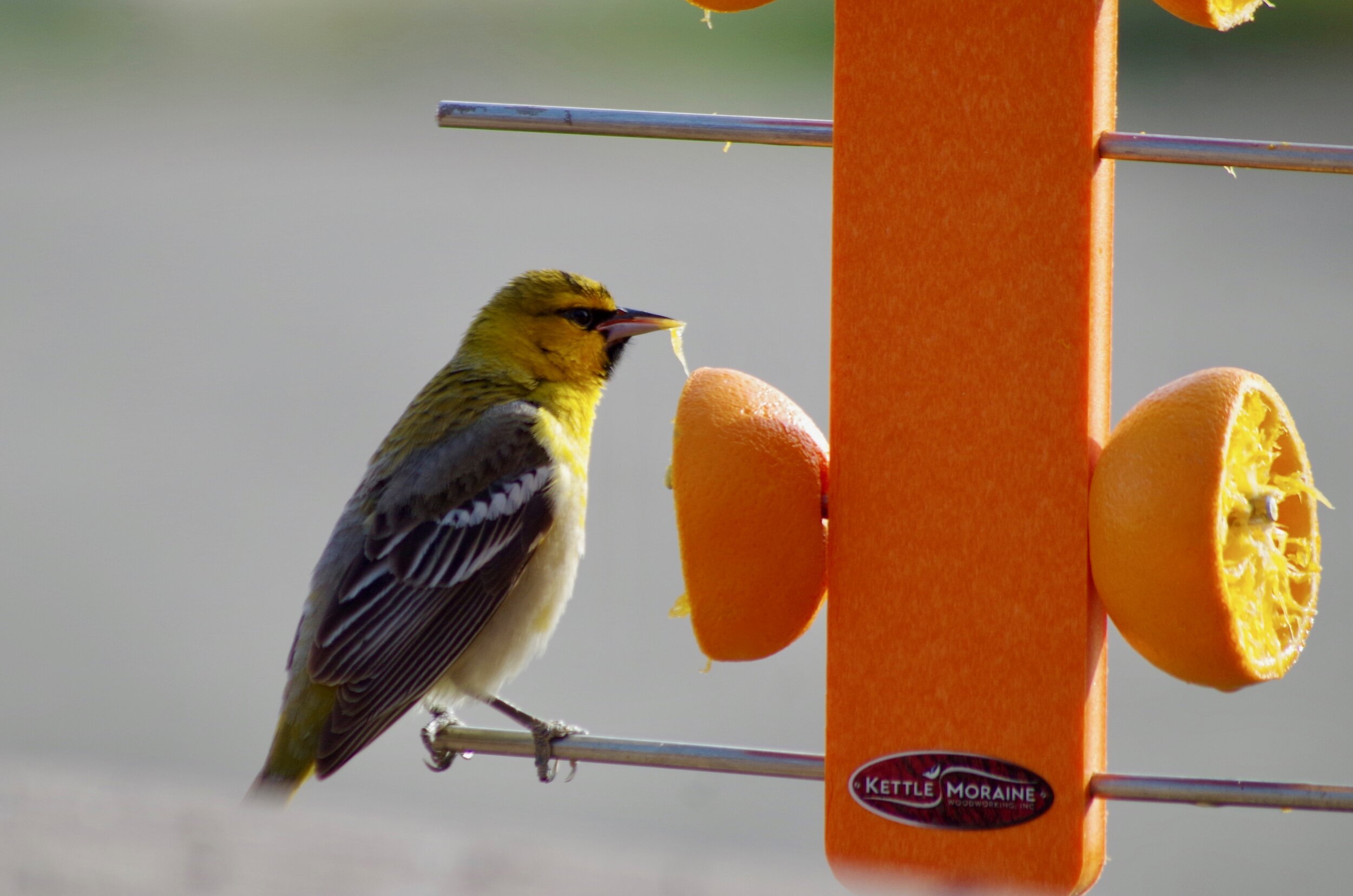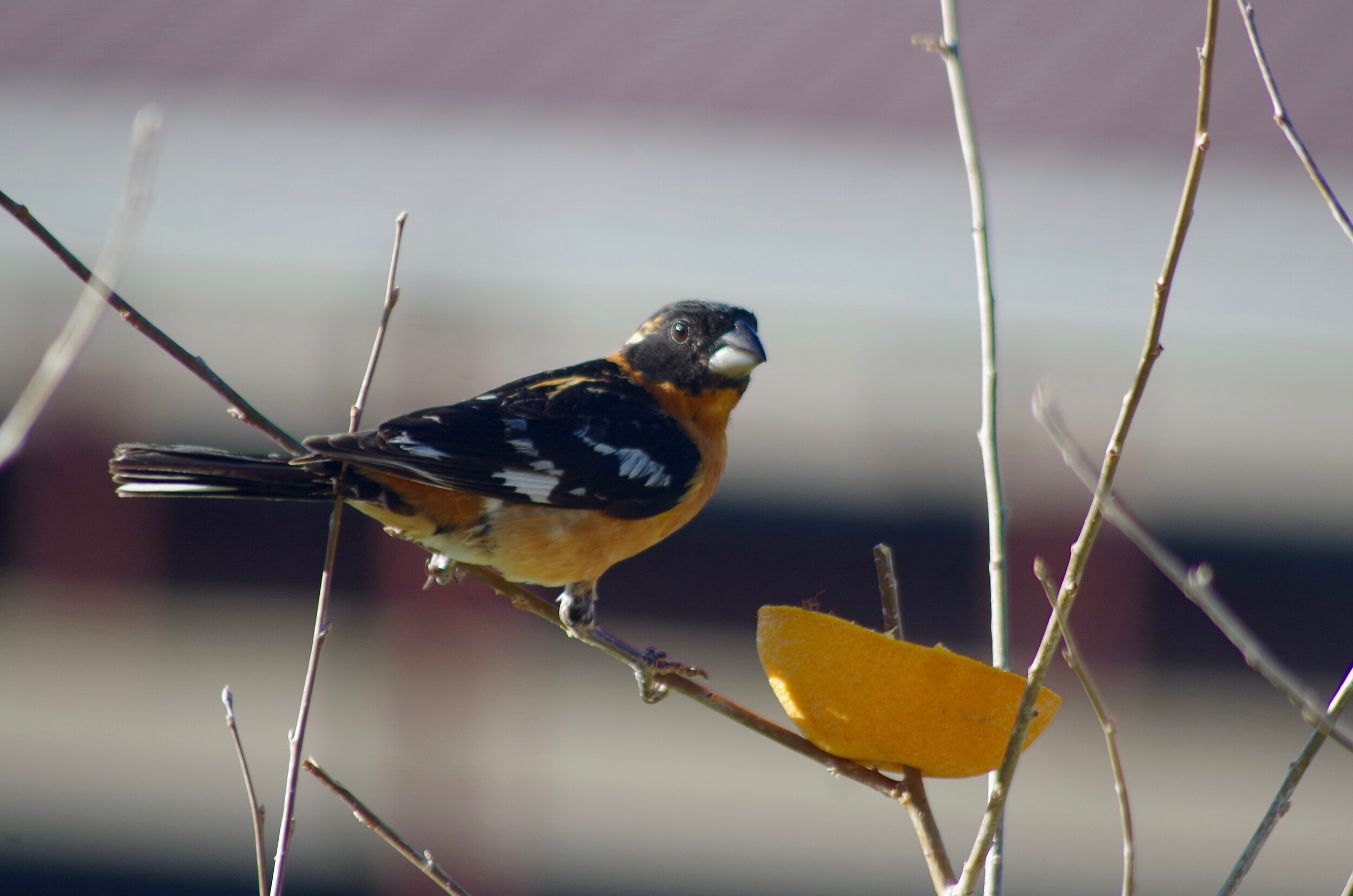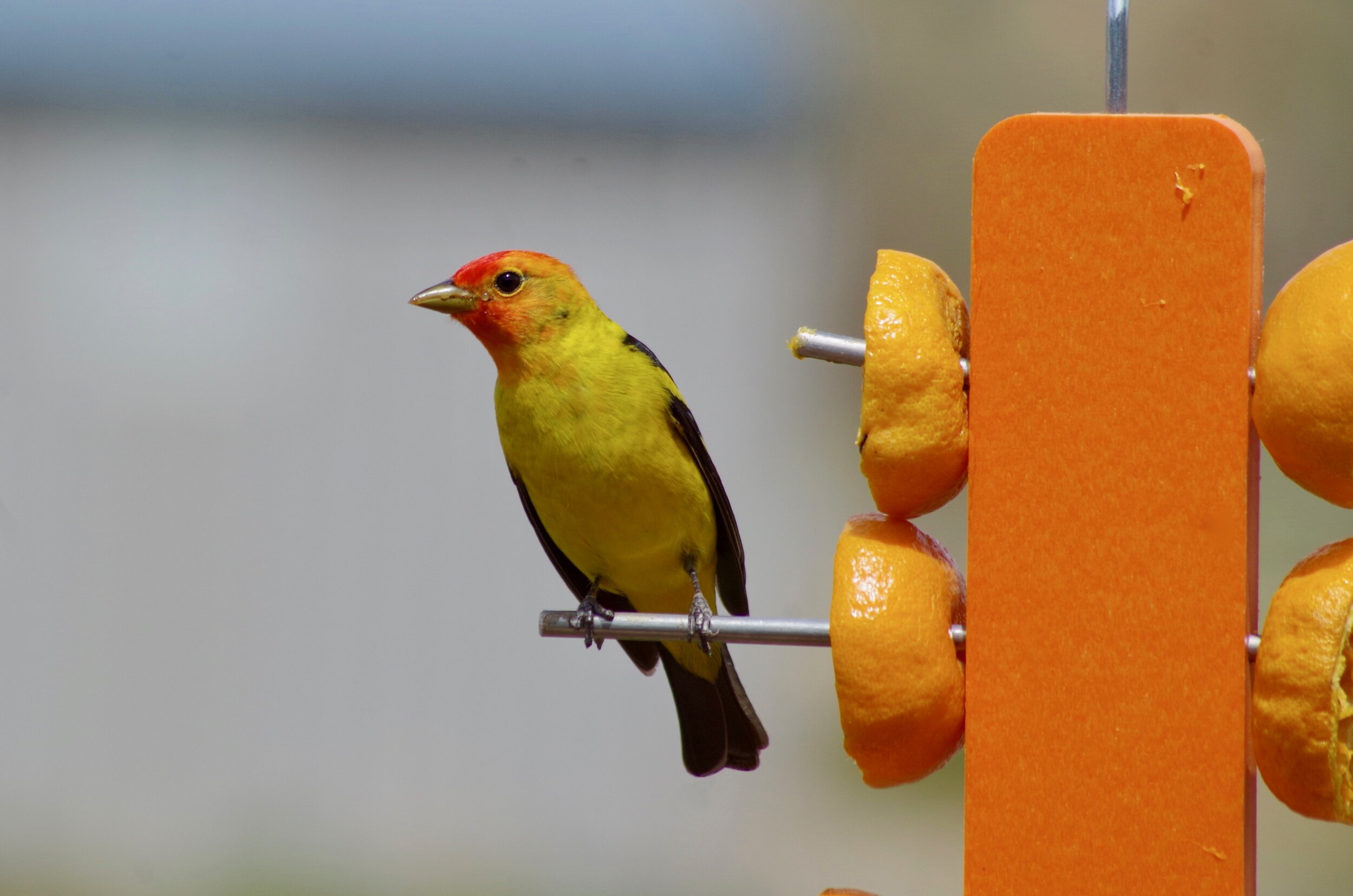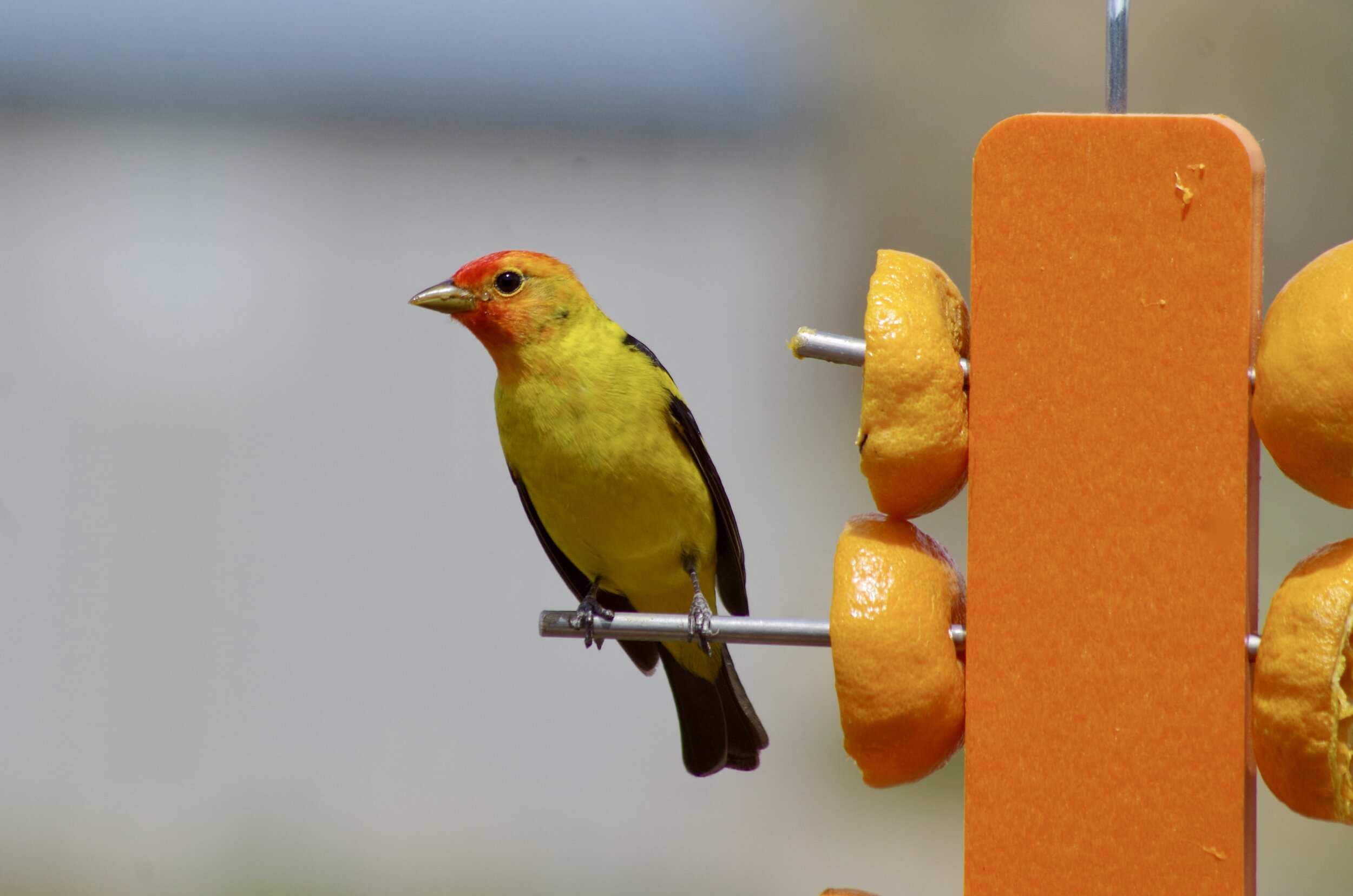In the sunshine of a Spring day, in early May, if I’m lucky, a bird unlike any of the others might pay me a visit. They come in a flash of bright orange that is so unlike what my eyes have been seeing all Winter, that I have to double take. Of course, usually by that time, they are on to me and take off! I stare longingly out the window for what feels like ages, waiting for them to come back, before I must continue on with my day and hope my offerings were good enough to keep them coming back for more.
Truthfully, I usually end up in a frenzy—grabbing extra oranges, grapefruits, clementines, or even apples from my produce drawer, and any jam or jelly I might have. Sure, there’s already oranges out there, but I want my yard to be a veritable buffet of sweet treats so they don’t decide the neighbor’s house looks more promising! I cut the sweet citrus fruits in half and skewer them up on tree branches and shepherds hooks, and stick grape jelly out in a little glass bowl on my deck railing. I go inside with fingers crossed and bated breath, and try to busy myself for a while. Within 20 minutes, I’m peaking out the window, again, and to my absolute delight, there is not just one, but TWO male Bullock’s Orioles, sampling the goods! YES!
HAPPY DANCE
Through the years, I have learned a few things about attracting orioles to my backyard. It requires a little bit of extra planning and preparation, but it is entirely worth the nominal extra effort to have such exquisite company! Today, I wanted to share some Tips for Attracting Orioles and Feeding Orioles with you, so that you may enjoy their sunshiney company on a spring day, as well!
Attracting Orioles to your Yard
Unlike many birds, Orioles are not SEED eaters!
Many birds at a traditional bird feeding station happily eat seeds. Some birds, like American Goldfinches, eat seeds almost exclusively. Orioles are nothing like these finches and sparrows. They like eating FRUIT, NECTAR, and INSECTS. In fact, I have never seen an oriole even try eating a black oil sunflower seed—they just don’t.
If you want to attract an Oriole to your yard, you need to offer food they actually want to eat!
Orioles spend half the year, from like September to March, overwintering in Central & South America. While they are down there, they eat a variety of fruits and insects, flowers and nectar. So when they are on their journey north, they will be looking for delicious fruits to fuel their travels, along with nectar and insects.
FRUIT—This is the easiest food to offer your Orioles—it doesn’t even require a special feeder. They are naturally attracted to the color orange and, in my yard, oranges always seem to be their preferred snack. I have two actual orange feeders, hanging at my feeding station, one homemade and one store-bought. They basically have perches and skewers that hold your fruit halves. But up until last year, I never even used a feeder. I would simply slice oranges (or grapefruits or clementines) in half and poke them on the ends of the shepherd’s hooks holding my feeders, or at the ends of tree branches.
If you are only going to do one thing to attract orioles to your yard, put out their favorite fruit—oranges!
JELLY—Another source of “fruit” you can offer the orioles is in the form of jellies, jams, and marmalades. Contrary to popular belief, orioles (and other fruit-eating neotropical migrants) will eat more than just grape jelly. Maybe concord grape jelly is their preferred, but last year, when I ran out of storebought grape jelly, I put out some plum jam and orange marmalade, and they gobbled it up. If you are offering jelly, you can use whatever inexpensive grape jelly the store has—I would advise you to avoid anything that is sugar free or made with artificial sweeteners like xylitol or aspartame, though.
NECTAR—Orioles will often alight hummingbird feeders looking for a source of quick energy from the sugar water or “nectar” as we call it. Unfortunately, their beaks are often too large to access the holes on a hummingbird feeder. You can offer them the same sugar water solution you mix up for your hummingbirds in a specially-made Oriole Nectar Feeder—a 4:1 water: sugar solution. Oriole Nectar Feeders that have orange on them are often the most attractive. Like hummingbird feeders, these need to be kept clean. You may also notice orioles visiting your flowers for nectar—I’ve heard some gardeners report them eating the flower, petals, nectar, & all!
INSECTS—Once nesting begins, I find the orioles seemingly disappear. Their diet switches from being full of fruit to being more protein-based—they need insects to raise a healthy generation of fledglings. I have been largely unsuccessful with offering dried meal worms, but you may be able to lure them in by offering live mealworms. Or better yet, plant some native plants in your yard, that host native insects and caterpillars, and you will be helping future generations of all sorts of birds, for years to come, even if you can’t see the results up close at your feeding station.
*On the rainiest, crappiest days of spring, on occasion, I have seen my orioles eat from the Suet feeders—although, I don’t feel that this is their preferred food of choice.
If you’re not 5 minutes early, you’re late!
Seriously! When it comes to Orioles, you will have the best chance of success if you catch their attention during spring migration, when they are winging their way north for the summer breeding season. This time will vary depending on where you live in the United States or Canada. Generally speaking, the closer the South America you live, the earlier they will pass through your neighborhood on their journey north. Orioles, like other neotropical migrant birds, overwinter in Central and South America. They start heading northward in March, so the more southern your location is, the earlier you are likely to see them. Here in Wyoming, I don’t see them until about the first week of May. If you would like to track the first sightings of Orioles, to try and guess when they may be arriving in your neck of the woods, you can use the website Journey North. If you like the kind of information on this website, be sure to Register for an account, and submit your First Sightings, as well.
The key to attracting orioles during spring migration, is having foods they prefer outside BEFORE they arrive. I start putting out orange slices around April 25th—10 days before their usual return, that way, even if they get back a little early, I am ready for them. Readiness is key, here. If they pass through your neighborhood and there’s nothing they want, they may just continue on their merry way. The years I have been able to successfully attract orioles to my yard, I have been ready with oranges, before their return.
Catch them among the tree-tops!
In addition to being much more shy than my other birds, orioles seem to hop from tree top to tree top. Therefore, if you are going to attract them to your yard, you need to have tall trees nearby and you need to place whatever nectar or jelly or fruit feeders you are offering them in their line of sight. If your oranges are under eaves or tight to the underside of a tree canopy, they will have a much harder time finding them. I try to put oranges right out in the open like a big billboard, advertising that they should swoop down from the treetops HERE!
Don’t forget water!
I’ve said it before and I’ll say it again: Birds love bird baths! Many birds that don’t even eat at your feeding station will stop by for a drink of water or a bath. Orioles are especially attracted to moving water so a bubbler or fountain will make your birdbath even more attractive to them.
Above all, be consistent!
Don’t be discouraged if you don’t get an oriole this year! Some folks try for a couple years before they can attract one! And your efforts may help to lure in another neotropical migrating bird, like a grosbeak or a tanager. In fact, the first year I tried to attract an oriole to my yard, I actually ended up with a delightful flock of Western Tanagers! I wasn’t expecting the adorable redheads to stop by, but I was pleasantly surprised to have them. I have also had many Black-Headed Grosbeaks stop by for a beakful of jelly.
So, if the orioles don’t find your house this year, try again next year! And if they do find your house this spring, keep the goodies stocked for them. If they clean out your oranges and you don’t replenish the supply for another two weeks, they will likely not be returning. Birds love consistency, and if you are not consistent in providing them with food, they will move along. In my garden, come summer, there is a time when the orioles seem to quit stopping by—at which point, I will scale back on the amount of fruit I am putting out. Then I begin scanning the tree tops for there pendulous, woven nests. In winter, I can spot them fairly easy, but in summer, as the trees are leafed out, it is such a challenge!
So, do you have Orioles stopping by your yard?! What have you done to attract them? Leave a comment below and share where you are and what kind of Orioles you have. I am in Wyoming, and the only species we have had so far, this year, are Bullock’s Orioles. Orchard Orioles occasionally visit our area, but so far, none have come to my backyard.
